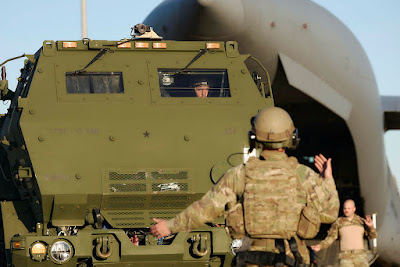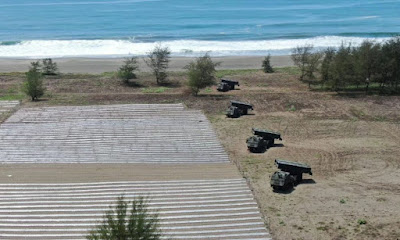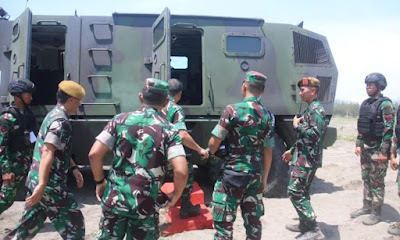viernes, 1 de agosto de 2025
MRLS: Pruebas con el HIMARS australiano
jueves, 10 de abril de 2025
Llegan los primeros HIMARS australianos
El Gobierno entrega el primer HIMARS australiano
lunes, 17 de junio de 2024
Malasia: Maniobras de artillería de cohetes "Magic Javelin"
La ejecución de Magic Javelin demuestra la preparación de la brigada de artillería de cohetes
El comandante del ejército (PTD), general Tan Sri Dato' Muhammad Hafizuddeain bin Jantan, tuvo la oportunidad de presenciar la ejecución de Sakti Javelin en Tanjung Hantu, Lumut, Perak.
Este ex también involucró a la Marina Real de Malasia (TLDM), la Real Fuerza Aérea de Malasia (TUDM) y las agencias de defensa civil locales para determinar la seguridad del ejercicio.
El antiguo Sakti Javelin es un ejercicio de disparo del Sistema de cohetes de corriente múltiple (SRLB) ASTROS II bajo el control del Cuartel General de la Brigada de Artillería de Cohetes (BAR). Este ex tiene como objetivo probar el nivel de preparación y eficiencia de los miembros en el control del ASTROS II SRLB guiado por el Sistema de Evaluación y Entrenamiento del Ejército (ARTEP). Para este disparo se dispararon un total de 128 cohetes.
El siguiente paso continuó con el cañón G5 MK III de 155 mm disparando 7 rondas. El propósito de esta toma se llevó a cabo para probar las capacidades de Base Bleed que ha estado en el inventario del Ejército (TD) desde 2001.
También estuvieron presentes el subcomandante del ejército, el teniente general Dato' Tengku Muhammad Fauzi bin Tengku Ibrahim, el comandante del ejército de Medan Occidental, el teniente general Dato' Pahlawan Hj Muhammad Huzaimi bin Sabri, jefe del Estado Mayor del Ejército (KSTD), el teniente general Dato ' Zaidan bin Atan, así como empleados superiores del ejército.
( TDM )
sábado, 16 de marzo de 2024
Indonesia: Maniobras con MRLS
3 de marzo El batallón de cohetes lleva a cabo entrenamiento de unidad básica (LSD) TW I TA. 2024
jueves, 14 de diciembre de 2023
Indonesia: Pruebas con sus MRLS Astros
400 cohetes destruyen miles de objetivos, Yonarmed 1 Kostrad realiza entrenamiento de entrenamiento con cohetes Astros
domingo, 15 de enero de 2023
Australia gastará mil millones USD en NSM y HIMARS
Australia gastará 1.000 millones de dólares australianos en NSM e HIMARS
sábado, 8 de octubre de 2022
Prototipo de MLRS tailandés
DTI Tailandia probó un prototipo del vehículo lanzacohetes multipropósito D11A para el Ejército Real de Tailandia
miércoles, 28 de septiembre de 2022
Mantenimiento en el sistema Astros indonesio
Yonarmed 10/Roket/Bradjamusti realiza entrenamiento UST (prueba de preparación para el combate) en un nivel sexy

Ejercicio con equipo de defensa Yonarmed 10 en forma de MLRS Astros II Mk 6 (fotos: Yonarmed 10/Roket)
jueves, 8 de septiembre de 2022
Tailandia codesarrolla con Israel el MRLS D11A
Tailandia y Elbit se asocian en el lanzacohetes D11A Multi-Multi-Barrel
martes, 24 de mayo de 2022
Indonesia: Los infantes de marina disfrutan ya de sus MRLS RM-70 de origen checo
MLRS RM-70 Vampire del cuerpo de infantería de marina indonesia

RM-70 MLRS Vampire fabricado por Excalibur Army, República Checa (foto: Marines)
KOMPAS.com - El Cuerpo de Infantería de Marina de la Armada de Indonesia tiene el sistema de armas principal (equipo de defensa) para el lanzacohetes Vampire RM-70 Multi Launch Rocket System (MLRS).
En un informe de tnial.mil.id, el 5 de agosto de 2021, los soldados del 1er Batallón de Cohetes Marinos realizaron un simulacro para disparar al Vampiro RM-70 en el Campo Hartono Marino Trisula Kesatrian, Cilandak, Yakarta del Sur.
En esa ocasión, soldados del 1er Batallón de Cohetes de Infantería de Marina realizaron un simulacro de tiro con el objetivo de volver a verificar la disponibilidad de armas, materiales y personal.
Esta actividad se llevó a cabo al mismo tiempo para perfeccionar y mejorar el profesionalismo, los instintos de combate y la capacidad de la dotación de armas para operar el RM-70 Vampire que se había convertido en su deber y responsabilidad.
Especificaciones del lanzacohetes RM-70 Vampire
El RM-70 Vampire es producido por la compañía de armas checa Ecxalibur Army Ltd., una nueva variante del RM-70 Grad MLRS.
En un informe de Army Technology, el lanzacohetes RM-70 Vampire tiene un peso total de 25.890 kilogramos con un campo de tiro de 20,3 kilómetros.

El sistema de lanzamiento de cohetes se usa para atacar una variedad de objetivos enemigos, incluyendo infantería, unidades de artillería, infantería motorizada, tanques y otros vehículos de combate.
El primer prototipo RM-70 Vampire se desarrolló en la primera mitad de 2015 y se llevó a cabo una prueba exitosa del arma en octubre de 2015.
El RM-70 Vampire está construido sobre el chasis del camión táctico militar Tatra T-815-7 8×8.
La configuración básica del lanzacohetes conserva el mismo diseño del RM-70 original, pero tiene un cableado rediseñado.

Sistema avanzado de control de tiro
La parte trasera del chasis del camión está montada con un lanzador de 40 disparos. El lanzacohetes mide 9,97 metros de largo y se eleva mediante cámaras de aire.El M-70 Vampire se opera mediante control electrónico en modo semiautomático o manual.
El lanzamiento del cohete lo lleva a cabo el operador, ya sea desde dentro de la cabina de la tripulación o desde un refugio cercano mediante un dispositivo de control remoto.

El MLRS tiene un sistema de control de fuego avanzado equipado con una computadora balística.
Además, también incluye un sistema de navegación inercial y un sistema de posicionamiento global (GPS), así como un sistema de mando y control. El periscopio panorámico PG-1M permite al operador apuntar al objetivo.
Kompass
viernes, 29 de abril de 2022
martes, 26 de abril de 2022
lunes, 8 de noviembre de 2021
Tailandia recibe sus nuevos MRLS de 122mm
DTI Thailand Delivered DTI-2 122mm Rocket Launcher

Thai Defense Technology Institute (DTI) hands-on modified Chinese Norinco Type 85 Self-Propelled Artillery Rocket Launcher (YW306) with 30 tubes 130mm rocket that replaced with domestic DTI-2 20 tube 122mm rocket to Royal Thai Army (RTA) at Artillery Division, Fort Sirikit, Lopburi province on 23 September 2021 (all photos : DTI)
Multiple-launched rockest system, Type 85, which has been in service in the Royal Thai Army (RTA) since 1988, is based on tracked vehicle Type 85 produced by Norinco China, which has been in service in the Royal Thai Army since 1987.
While RSP 30 Type 85 has been renovated and will continue to be stationed, but the Type 85 multi-barreled rocket launcher, size 130mm, 10 pipes, installed with the original Type 85 system, is an obsolete system that has a firing range of only 10 km and has a long service life already trusted.

Modification project, MLRS Type 85, installed a multi-barreled rocket launcher DTI-2, size 122mm, 20 tubes, firing range 40km, arrived at the stage of delivery to the Royal Thai Army for testing on September 23, 2021.
Defense Technology Institute DTI (Defence Technology Institute) has tested the launch of the DTI-2 122mm multi-barreled rocket launcher installed on the MLRS Type 85 several times.
As part of DTI's high-performance rocket development program, the 122mm DTI-2 rocket is a fully self-developed system by Thailand. It has been tested several times with the Thai Army's 40-tubes SR4 self-propelled rocket launcher system.
DTI also has a multi-purpose rocket project, together with the Royal Thai Navy (RTN) based on the Israeli Elbit Systems PULS (Precise & Universal Launching System) self-propelled rocket launcher system.
AAG































